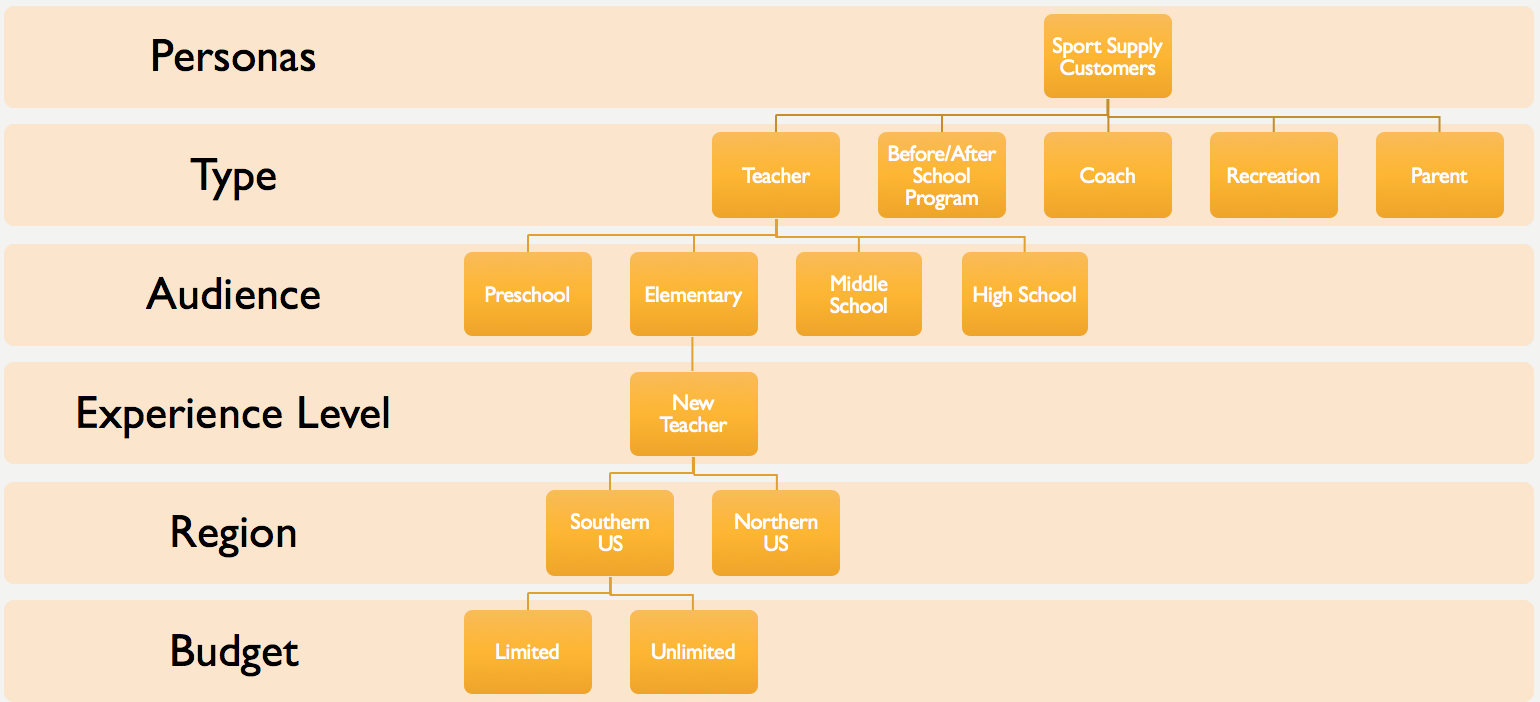Now that we’ve established the history, let’s discuss the future!
The Catalog Business Model
Here’s where catalog companies get tripped up. While I’m oversimplifying, I imagine most thrive on a buyer’s journey that goes something like this:

For all intensive purposes, the business model relies on competing (one-on-one) with every adult’s least favorite thing… Bills.
When these catalog companies transition to the Internet, the business model no longer works. They are no longer competing one-on-one with a customer’s bills, they’re no longer the first pretty thing the customer sees, and the days of “if I build it, they will come” success are gone. Now, they’re one of a thousand “catalogs” that a person can get at any moment of the day and from any device. NOW, they’re competing with everyone from Amazon to Joe Schmoe’s blog.
The internet is not a scam…
 To drive home this point, let’s reverse it. If 100 companies could send an equally well-produced catalog to a customer every time they asked about a product, would they still be as profitable? Would they need to change anything? Now let’s say that the USPS comes back to all 100 of them and says “Sorry Guys, we’re breaking our backs delivering all of these catalogs and people aren’t looking at most of them, so we’re only going to deliver the 10 most popular from now on”. Who would be in the top 10? Now consider that there are currently over 1 billion websites on the World Wide Web and, no matter what the market is, there are thousands of sites competing for the top 10 spots. Is your company still in the top 10?
To drive home this point, let’s reverse it. If 100 companies could send an equally well-produced catalog to a customer every time they asked about a product, would they still be as profitable? Would they need to change anything? Now let’s say that the USPS comes back to all 100 of them and says “Sorry Guys, we’re breaking our backs delivering all of these catalogs and people aren’t looking at most of them, so we’re only going to deliver the 10 most popular from now on”. Who would be in the top 10? Now consider that there are currently over 1 billion websites on the World Wide Web and, no matter what the market is, there are thousands of sites competing for the top 10 spots. Is your company still in the top 10?
So, where do you start?
First, start now! If you read my previous blog, you know that Aldus Manutius was 60 years late, in my opinion, but we still never hear about him. Sears was a beacon of American success for 103 years, but 300 years from now they might just be “that company that had a cool building named after them until 2009”.
Successfully making the transition to the digital world requires a fundamental reprogramming of the company’s DNA, a genuine commitment to your company’s future and the same entrepreneurial spirit that got the company started in the first place.
Step One: Understand Your Hesitation and the Financial Impact
I know how daunting “reprogramming your company” must sound! And, frankly, I might have better odds making a pitch to invest your company’s current worth in South African diamond mines, right? But stick with me for a minute…
Catalog Mentality
 Part of what makes this sound so daunting is the “catalog mentality”. You probably spend months putting together a catalog. Your team undoubtedly spends countless hours scrutinizing photos, building page layouts, cramming the most information into the smallest space to keep page costs down, checking every page more times than Santa so you can get the best ROI and relentlessly going over mailing lists to make sure you’re spending all of this time and money on real customers… Then, the print deadline hits, so you send it out and hope you’ve created something that will make a profit. Depending on your catalog cycle it could be weeks, months or possibly even a year before you can make any changes.
Part of what makes this sound so daunting is the “catalog mentality”. You probably spend months putting together a catalog. Your team undoubtedly spends countless hours scrutinizing photos, building page layouts, cramming the most information into the smallest space to keep page costs down, checking every page more times than Santa so you can get the best ROI and relentlessly going over mailing lists to make sure you’re spending all of this time and money on real customers… Then, the print deadline hits, so you send it out and hope you’ve created something that will make a profit. Depending on your catalog cycle it could be weeks, months or possibly even a year before you can make any changes.
eCommerce Mentality
 eCommerce is the polar opposite. There aren’t limits to the amount of content you can write, the number of pages you can have or the number of changes you can make. Images, content, prices and products can be fixed or changed instantaneously. eCommerce operates at an unprecedented pace. AND, for the first time in history, you can start a meaningful conversation and truly engage with your customers, one-on-one, through your website and social media. You can ask questions about potential new products, existing products, your customer service, what they want, what they think, what they like… You now have a dedicated focus group of your actual customers at your disposal 24/7.
eCommerce is the polar opposite. There aren’t limits to the amount of content you can write, the number of pages you can have or the number of changes you can make. Images, content, prices and products can be fixed or changed instantaneously. eCommerce operates at an unprecedented pace. AND, for the first time in history, you can start a meaningful conversation and truly engage with your customers, one-on-one, through your website and social media. You can ask questions about potential new products, existing products, your customer service, what they want, what they think, what they like… You now have a dedicated focus group of your actual customers at your disposal 24/7.
But Wait… There’s more! Successfully running an eCommerce site will cost a small fraction of what you’re currently spending on your internal catalog teams, print/shipping costs and the systems/people required to get orders from the catalog to your warehouse. A marginal decrease in catalog spend will likely give you the financial means to create a dedicated, fully financed eCommerce team.
Step Two: Make Sure it’s Right for the Company
Before you even think about suggesting a priority shift to key stakeholders, try this. Send an email/survey out to your employees and ask the following questions:
- Have you made a purchase from a non-company catalog in the last 3 years?
- Excluding in-store purchases, was your last purchase made from a catalog or online?
- How do you typically shop for products today?
- Where do you see yourself shopping in 10 years?
If the feedback suggests that catalogs are still the way to go, then you’re good. You’re welcome to call me in a few years to discuss the South African Diamond market.
If not (as I suspect) then it’s time to abate the company’s catalog-centric business model and move it forward!!
Step Three: Build the Team
You should build a team that can operate independently of your catalog team. Ideally, this team includes one person for each essential eCommerce role. I’d recommend creating the following:
- eCommerce Director
- SEO Manager
- SEM Manager
- Social Media Manager
- Email Manager
- Photographer
- Videographer
- Graphic Designer
- Web Programmer
- Copy Writer
- Data Analyst
- Team Coordinator
Hopefully, you’re now asking yourself, “What happened to reprogramming the company’s DNA? This sounds more like creating a separate company”. You’re right, it certainly does sound like that! Change is hard and reprogramming DNA isn’t easy! In my experience, this step is the hardest.
When you’re making this transition, you’ll essentially have 3 options:
- You can call a company-wide meeting and say “Catalogs are out, we are an eCommerce company now”
- Pros: It’s to the point.
- Cons: You’ll probably only incite panic and chaos
- You can create an eCommerce team and then move each person into one of your existing catalog teams at some point
- Pros: You give the eCommerce team time to establish a digital presence. You allow the catalog teams to feel more security and control in the transition
- Cons: You will probably lose most of your eCommerce team and those who stay will probably be frustrated by the focus and pace of the catalog team
- You can create the eCommerce team knowing that it will one day replace your catalog team and move catalog resources to the eCommerce team over time
- Pros: The eCommerce team has time to establish a digital presence and incoming employees will be offered new challenges within a growing team
- Cons: Higher level positions on the catalog team will eventually become obsolete. Your eCommerce team will need to establish an effective training protocol for incoming catalog employees as well as new opportunities for team members with varying skills.
Step Four: Identify your customer personas.
Yes, you have catalog people! They’re predictable and provide profits. But your customers, if you’re lucky, extend beyond the model you are relying on. So figure out who they are!
Seemingly small differences in your customers can make a huge impact in the digital strategy your team creates.
Let’s use selling academic sports equipment as an example. Teachers, coaches and parents all have different motives, expectations and shopping habits. They all want to know different things. Teachers have different questions based on their grade level, experience, location, budget, etc. Identifying customers and targeting them with information that’s unique to them is imperative in the digital age.

Now let’s say you have thousands of products. Of those, you have 80 basketballs. In a catalog world, you want to differentiate those 80 basketballs visually so the customer can quickly find the one they’re looking for. You’ll probably use words like “best”, “toughest”, or “most durable”.
eCommerce is different though. Online you have the opportunity to use your 80 basketballs to specifically target your buyer personas. For example:
- Basketball A is the best first ball for new teachers. It features helpful guides that make explaining basketball fundamentals a little easier no matter how old your students are.
- Basketball B is a durable high school level game basketball. Coach and league approved.
- Basketball C is fun new way to introduce basketball to preschoolers! Teachers and parents will love how soft they are and won’t have to worry about little ones getting hurt.
Tailoring content and changing simple things like tone (which I hope you picked up on) can impact buying behavior. If the content, in this hypothetical example, hadn’t been created with buyer personas in mind there’s a good chance I would’ve lost a sale.
Creating an online experience that engages each of your customer personas will not only improve your digital value, but it’ll increase your conversion rate and ultimately your revenue.
Step Five: Understand Digital Shoppers
Chances are you’ve done a google search or two. How do you search? What do you search for? What is your intent? How often do you deviate from your intent? How often do you get to page 2 on a Google search? Let’s please let go of the notion that customers somehow use the internet differently than we do.
Online searches can be broken down into four categories:

Herein lies a fundamental issue in transitioning from a catalog to an eCommerce site. If Mr. Sears sent a catalog that was comprised of 25% news, 25% events/travel, 25% DIY and 25% product, he would’ve failed. We never would’ve have heard about him. But instead he capitalized on the consumer’s needs in the moment and succeeded. If you create a website today that is 100% retail, you’re failing to capitalize on, at best, 75% of the consumer’s need. Think about that…
(Of course, Jeff Bezos might disagree with that statement. But I’m guessing you’re not Amazon, and let’s not forget that Sears once held the “top dog” title too.)
Step Six: Make a Plan
You can no longer rely on a list of addresses to make money. You can’t just focus on what you’re selling in the digital world until you are firmly established as an online retailer. You’re starting off as a digital freshman. This is where re-learning how to think comes in. But look, it’s actually easier than it seems… You are already an expert in your industry! What do YOU want to know? Where do YOU want to go? What do YOU want to do? What do YOU want to buy?
Creating content is one thing, but creating content you would actually want to read (and find valuable) is essential to successfully making the transition. Dedicate resources to providing your customers with everything they want to know! You probably wont be able to draw a straight line to ROI, but it is valuable! It’ll expand your footprint and help to establish you as an expert in your field.
Step Seven: Keep Asking Moore Questions!
Allow me to digress for a moment… I’m in my 30s. I’m young and very in touch with emerging tech and the digital landscape. I joined Facebook in late 2004. However, there are times that my oldest daughter will show me something I wasn’t expecting to EVER see (EX: Yubo a.k.a. “Tinder for teens”) or will use technology in an unexpected way. There have also been countless times throughout my career that one of my employees or interns made an absolutely brilliant suggestion that was simply based in how they use the internet.
If I’m being completely honest, it actually took me a month or two to get on board with texting when it became an option (I had a RAZR, so it wasn’t all that exciting back then). Fast forward to today… My one year old can open the calculator, she’s figured out that she can scroll through my notifications to open apps AND she can open the camera when my phone is locked, switch to video, record videos of the couch, ceiling or herself and watch video she just took.
Here’s my point…
Technology is changing rapidly. If you apply Moore’s Law to the digital world in general, it would stand to reason that asking more questions across age groups is the best way to create a transition that is sustainable.
Step Eight: Seize the Moment, Push Limits and Move Forward
Mr. Sears took an almost 400 year old idea and created the largest retailer in the US for over 100 years. But if catalogs progressed as quickly as the internet, they would not only look very different today but Sears would’ve had to work much harder to keep its spot.
You’ve been given a once in a lifetime opportunity to seize the moment! You can push the limits of this channel and bring the digital world in new directions. You can take your company into a new era and move it forward. But you have to start now.
I’m a strategist, designer, marketer, developer and process creator with a passion for helping companies overcome obstacles.